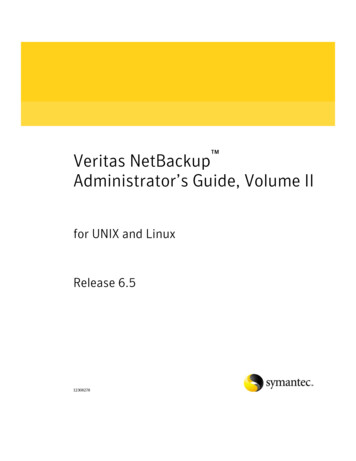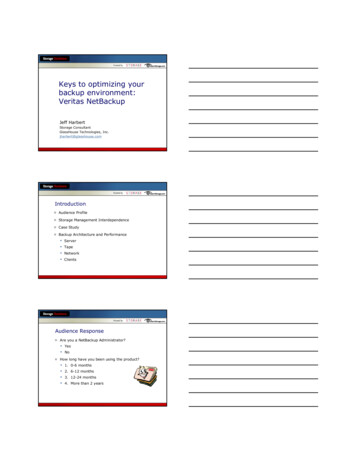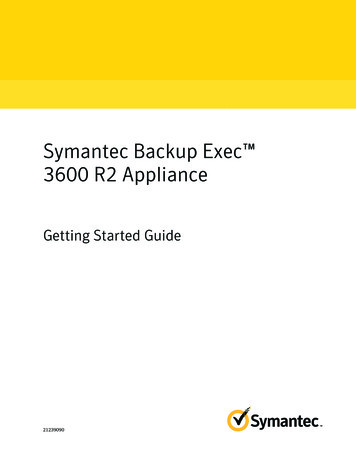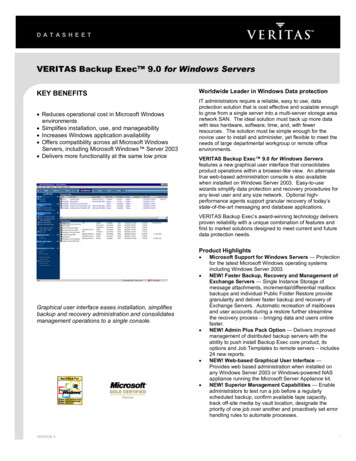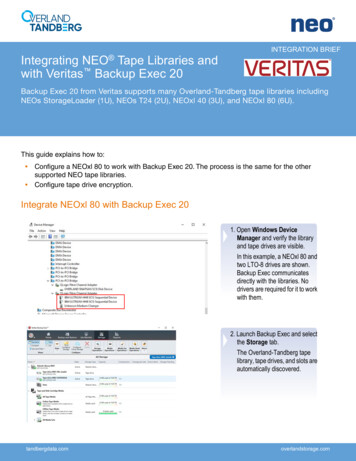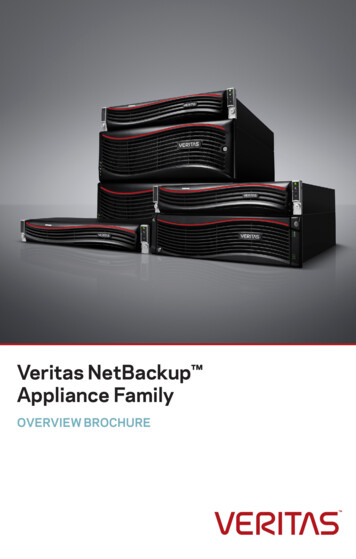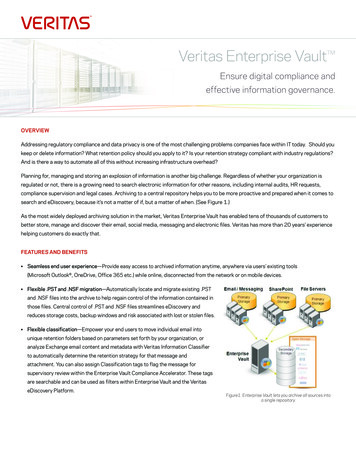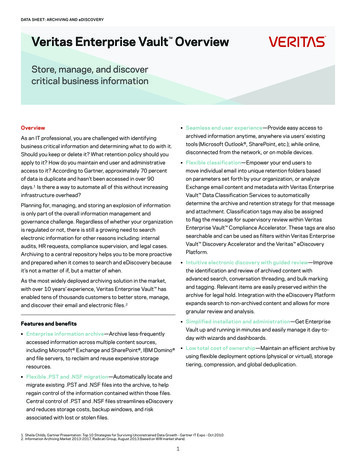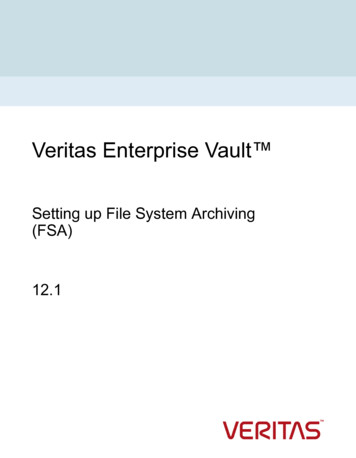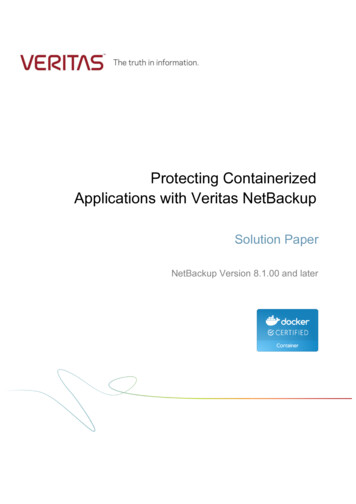
Transcription
Protecting ContainerizedApplications with Veritas NetBackupSolution PaperNetBackup Version 8.1.00 and later
ContentsAbout this document . 1Protecting Application Data with NetBackup Client Container . 1NetBackup Client Container Compatibility . 1Features Not Supported by the NetBackup Client Container . 1NetBackup Client Container Deployment Strategies in Kubernetes . 2Deploy NetBackup Client Container in the Application Pod . 2Deploy One NetBackup Client for Multiple Application Pods . 3Dump and Sweep Approach for the NetBackup Client Container . 4Deploying the NetBackup Client Container . 5Obtaining the NetBackup Client Container . 6Prerequisites for NetBackup Client Container . 6Updating the Application pod YAML file. 7The NetBackup Client Container entry point . 8Deploying Certificates . 9Creating a NetBackup Policy . 10Security considerations . 10Restoring persistent volume backups . 10Code samples for reference . 11
Protecting Containerized Applications with NetBackupSolution PaperAbout this documentThis document provides information about the NetBackup solution for protecting persistent volumedata in a container environment.The document contains instructions for deploying the NetBackup Client Container image incontainer environment to protect persistent volumes using NetBackup version 8.1 or later.Protecting Application Data with NetBackup Client ContainerTo protect applications deployed in containers, Veritas now provides a NetBackup Client that canbe deployed as a container. The NetBackup Client Container leverages the NetBackup policystructure to run backups. Depending on the level of protection required, the NetBackup ClientContainer can be used to protect containerized applications in the following ways: Protect application data stored on persistent volumesProtect application data using a staging areaThe NetBackup Client Container solution is available through a docker image.NetBackup Client Container CompatibilityVeritas provides NetBackup Client Container images based on CentOS Linux 7 for NetBackupversions 8.1 or later.NetBackup Client Container is compatible with all Master and Media server platforms and existinglicensing entitlements.The NetBackup Client Container supports standard NetBackup network topologies. ForKubernetes support of IPv6, check the appropriate issues on Github. IPv6 supportIPv4/IPv6 dual stack supportFeatures Not Supported by the NetBackup Client ContainerWith this version, following features are not supported: Backup, Archive, and Recovery user interfaceUse as a VMware proxySnapshot clientReplication directorSAN client1
Protecting Containerized Applications with NetBackupSolution PaperNetBackup Client Container Deployment Strategies in KubernetesThe container environment is dynamic wherein, applications are added or removed regularly. Forexample, an application that is running on one node of a cluster on a certain point can be runningon a different node when restarted. Typically, the orchestrator decides which application runs onwhich node and when. The only thing persistent in such an environment is the storage. To protectstorage in such an environment, Veritas offers a dynamic solution through the NetBackup ClientContainer in a way that:1. NetBackup Client Container can reside with the application and operate from the nodewhere the application is running. For this, deploy one NetBackup Client Container perapplication pod as a sidecar container.See, Deploy NetBackup Client Container in the Application Pod.2. NetBackup Client Container protects the persistent storage from a single point from where ithas access to volumes. For this deploy one NetBackup Client Container to protect multipleapplications pods.See, Deploy One NetBackup Client for Multiple Application Pods.Also, a dump and sweep approach can be used for both the deployments by mounting a dumpvolume.See, Dump and Sweep Approach for the NetBackup Client Container.Deploy NetBackup Client Container in the Application PodA NetBackup client container can be deployed per application pod. In this method: The NetBackup Client Container runs as a sidecar in the application pod. This ensures thatthe application and NetBackup Client Containers share the same lifecycle.The persistent volume(s) requiring protection must be mounted on both the application andNetBackup Client Containers.This solution offers: Simplicity of management for the NetBackup administrator.Best throughput.Efficient use of NetBackup core technologies like accelerator, client direct backup, etc.Capability to catalog each application's data under its unique name.A typical NetBackup client restore experience.The following diagram illustrates a typical deployment of NetBackup Client Container as a sidecar.2
Protecting Containerized Applications with NetBackupSolution PaperDeploy One NetBackup Client for Multiple Application PodsDeploying one NetBackup Client Container to protect multiple applications pods is suitable when: The application owner does not want to incorporate the NetBackup Client Container imageinto their pod.The number of external IP interfaces available to the cluster are limited.To minimize the NetBackup footprint on the cluster.One NetBackup Client Container can be deployed per node of the Kubernetes cluster or oneNetBackup Client Container per cluster depending on: Access mode of the persistent volumes: ‘ReadWriteOnce’ volumes are available only onone node and ‘ReadWriteMany’ volumes are available on multiple nodes of the cluster.Desired client throughput.In this approach, mount all the volumes that need protection in the NetBackup Client Container. Itis not possible to mount volumes after the pod has started. The administrator must know inadvance the volumes that need protection and must define them in the NetBackup Client Containertemplate before the pod is created.All protected applications are cataloged under the same NetBackup client name. Thus, create oneNetBackup policy per application and assign keywords specific to that application.The following example shows how different policies are created for each application protected byone NetBackup Client Container.3
Protecting Containerized Applications with NetBackupSolution PaperAlso, tune the number of jobs per NetBackup Client Container depending on your environment.The following diagram illustrates the scenario.Dump and Sweep Approach for the NetBackup Client ContainerWith the dump and sweep approach the application pods that need protection mount the dumpvolume in addition to their data volume(s). The application owner dumps the application data to thedump volume. NetBackup sweeps the dump volume periodically using a NetBackup Standardpolicy.4
Protecting Containerized Applications with NetBackupSolution PaperAll protected applications are cataloged under the same NetBackup Client name. Thus, create oneNetBackup policy per application and assign keywords specific to that application.The following diagram illustrates the dump and sweep approach when deploying one NetBackupContainer for multiple application pods.Deploying the NetBackup Client ContainerThe NetBackup Client Container solution is available through a docker image.You can choose the pre-built image that is provided by Veritas or choose to build one using theNetBackup client files and docker files.The following diagram illustrates the different tasks you need to perform to deploy the NetBackupClient Container and protect the applications.5
Protecting Containerized Applications with NetBackupSolution PaperAs illustrated in the diagram, refer to the following topics to complete the tasks:1.2.3.4.Obtaining the NetBackup Client ContainerUpdating the Application POD YAML fileDeploying CertificatesCreating a Standard NetBackup PolicyObtaining the NetBackup Client ContainerFrom Docker StoreRun the following command to obtain the NetBackup Client Container docker image.docker pull store/veritasnetbackup/client:8.1.xFrom Veritas Support Site1. Go to https://www.veritas.com/support site.2. Click Licensing. You are directed to the Veritas Account Manager page to access yourVeritas account.3. Enter your user credentials to access your Veritas account. You are directed to the VeritasEntitlement Management System site.4. On the Entitlements menu, use your Entitlement ID to locate and download the ClientContainer Image for NetBackup version you are need. NetBackup 8.1 Client Container.tar.gz NetBackup 8.1.1 Client Container.tar.gz NetBackup 8.1.2 Client Container.tar.gz5. In the Actions column against the software you want to download, click Download.6. Extract the tar.7. Add the image to docker repository by running the following command:docker load -i NetBackup 8.1.x Client Container.tarPrerequisites for NetBackup Client ContainerThe following prerequisites must be met before deploying the NetBackup Client Container: External IP address or hostname: This hostname is used to configure the NetBackup ClientContainer on the NetBackup Master Server.The NetBackup Client Container must not be deployed in a pod that is managed by a controllerobject which produces replicas (for example, deployments, replica sets).Expose the following TCP ports:6
Protecting Containerized Applications with NetBackupSolution Paper o PBX: 1556o vnetd-nbrntd: 13724Persistent storage for NetBackup data, logs, and configuration. One persistent volume can beprovided for all or one for each.Storage for dump and sweep staging area, if using that method.Updating the Application pod YAML fileAs part of deploying NetBackup Client Container, update the application pod YAML file with detailsof the NetBackup Client Container and then run the command for creating the pod. For example,kubectl apply -f file name .yamlFollowing is a sample YAML file for Kubernetes orchestration:apiVersion: v1kind: Podmetadata:name: application-podlabels:pod: application-podspec:hostname: client-name volumes:- name: nb-client-volpersistentVolumeClaim:claimName: nb-client-pvc- name: application-volpersistentVolumeClaim:claimName: application-pvccontainers:- name: nginximage: nginx:latestvolumeMounts:- mountPath: /usr/share/nginx/htmlname: application-vol- name: nb-clientimage: store/veritasnetbackup/client:8.1.2command: [ "/entrypoint.sh" ]args: [ "-M", " master-server-name ", "-c", " client-name " ]livenessProbe:exec:command:- /health.sh7
Protecting Containerized Applications with NetBackupSolution PaperinitialDelaySeconds: 60periodSeconds: 180volumeMounts:- mountPath: /mnt/nblogssubPath: nblogsname: nb-client-vol- mountPath: /mnt/nbcfgsubPath: nbcfgname: nb-client-vol- mountPath: /mnt/nbdatasubPath: nbdataname: nb-client-vol- mountPath: /backupname: application-vol--apiVersion: v1kind: Servicemetadata:name: client-name spec:type: LoadBalancerloadBalancerIP: external-ip-address selector:pod: application-podports:- name: pbxport: 1556- name: vnetd-nbrntdport: 13724The NetBackup Client Container entry pointThe NetBackup Client Container entry point is entrypoint.sh.Commandentrypoint.sh -c client-name [-i] [-M master-server ] [-m media-serverlist ]Options-c client-name Required parameter. Use the client name as configured in the client's bp.conf. Certificate isgenerated for this client name.8
Protecting Containerized Applications with NetBackupSolution Paper-iRun the container in interactive mode.-M master-server Required when the container is started for the first time. It is needed to create bp.conf. Insubsequent runs, it is optional.-m media-server-list Space delineated list of the media servers that are added to the client's bp.conf. This must be thelast argument.Deploying CertificatesDeploy certificates using one of the following methods: Deploy certificate manually. Follow the steps mentioned in the following technote.https://www.veritas.com/support/en US/doc/21733320-127424841-0/v121744015127424841You must execute the steps described in the technote in the container.Deploy certificate using secrets. Follow the steps.1. Get RSA key and token from NetBackup admin for the NetBackup ClientContainer hostname.2. Create files for the rsa key and token that contain the rsa key and tokenrespectively.3. Create secret. Run the following command:kubectl create secret generic rsa-token-key --fromfile rsa key /rsa key --from-file token /token4. Mount the secret at /etc/nb-secret-vol under NetBackup Client Containerthrough YAML definition.Following is a sample snippet of the YAML, considering the secret is created withname rsa-token-key snip: under NetBackup Client container volumeMounts:- mountPath: "/etc/nb-secret-vol"name: client-secret-volume /snip snip: under volumes volumes:- name: client-secret-volumesecret:secretName: rsa-token-key /snip Note: After deleting the pod along with persistent volumes, deploy certificate using reissue token ifthe same client name or IP is used that was already configured in NetBackup.9
Protecting Containerized Applications with NetBackupSolution PaperCreating a NetBackup PolicyNetBackup Client Container uses the Standard or other policy type for running backup jobs.ParameterValuePolicy TypeStandard or other policy typeAttributesSelect according to the volume.For example, Select Follow NFS, if the persistent volumetype is NFS.SchedulesAs appropriate for the application.In case of dump and sweep, there must be coordinationbetween the application and backup administrators. Theapplication dump and backup activities must take place atdifferent times.Client NameAs defined by the Kubernetes service object.Backup SelectionsApplication volume path(s) as visible in the NetBackupClient Container.In case of dump and sweep, the dump volume path asvisible in the NetBackup Client Container.It is recommended to structure the data in the dumpvolume such that there is one directory per application.For information on creating policies, see Veritas NetBackup Administrator's Guide, Volume I.Security considerationsData stored on persistent volume provided for mount path /mnt/nbcfg stores critical security datasuch as keys and certificates for secure communication. If someone gets access to this data, theycan impersonate the client. Thus, data must not be shared with any container other than theNetBackup Client Container.Restoring persistent volume backupsFor restoring persistent volume backups, consider the following: To restore to a volume that is already mounted on NetBackup Client Container (Original oralternate volume):10
Protecting Containerized Applications with NetBackupSolution PaperUse the Backup Archive and Restore console or the bprestore command torestore.o As the backups for multiple application pod are cataloged under same client name,ensure that separate policy is used per application pod. Also, ensure that keywordsare added for identifying the backups corresponding to specific application. Usethese as filters to identify the backup to be restored.To restore to a volume that is not mounted on the NetBackup Client Container:o Deploy a new client container which will mount a destination volume for restore.o Deploy the certificates. See, Deploying Certificates.o Use the Backup Archive and Restore console or the bprestore command torestore.o Note: Recovery flow for dump and sweep backup is a two-step process -- restores the dump anduses the corresponding application tools for recovery.Code samples for referenceYou can refer to code samples for NetBackup client container usage uploaded at the backup-client-container-code-samples11
The NetBackup Client Container solution is available through a docker image. NetBackup Client Container Compatibility Veritas provides NetBackup Client Container images based on CentOS Linux 7 for NetBackup versions 8.1 or later. NetBackup Client Container is compatible with all Master and Me
